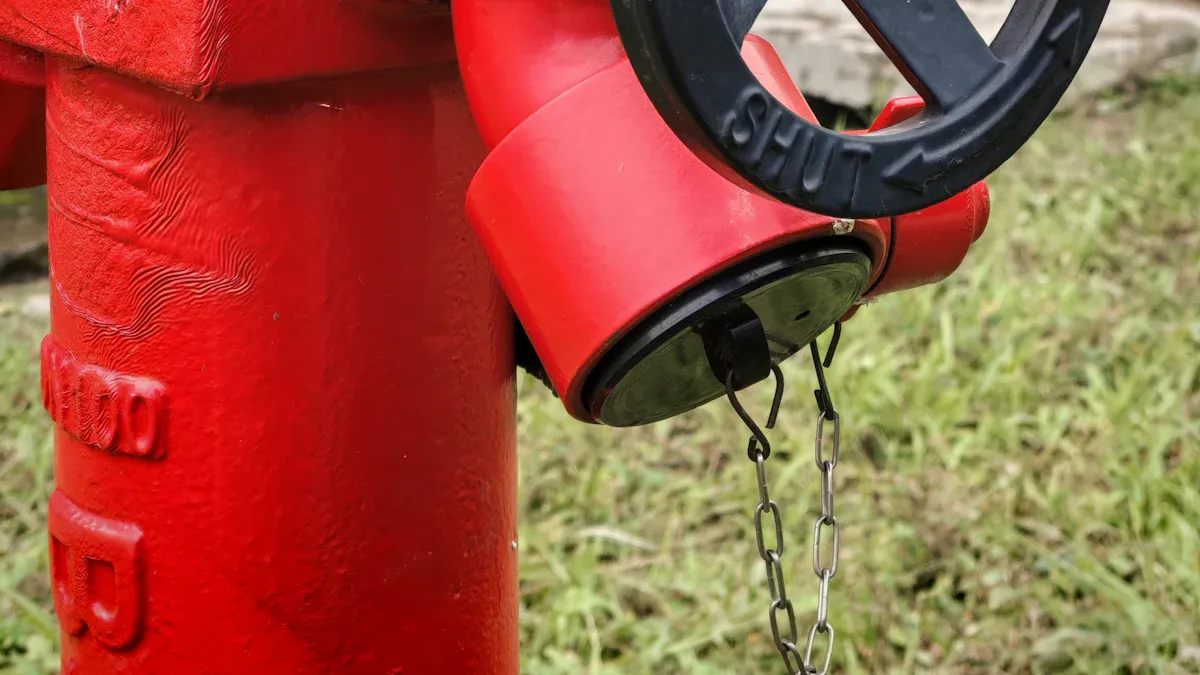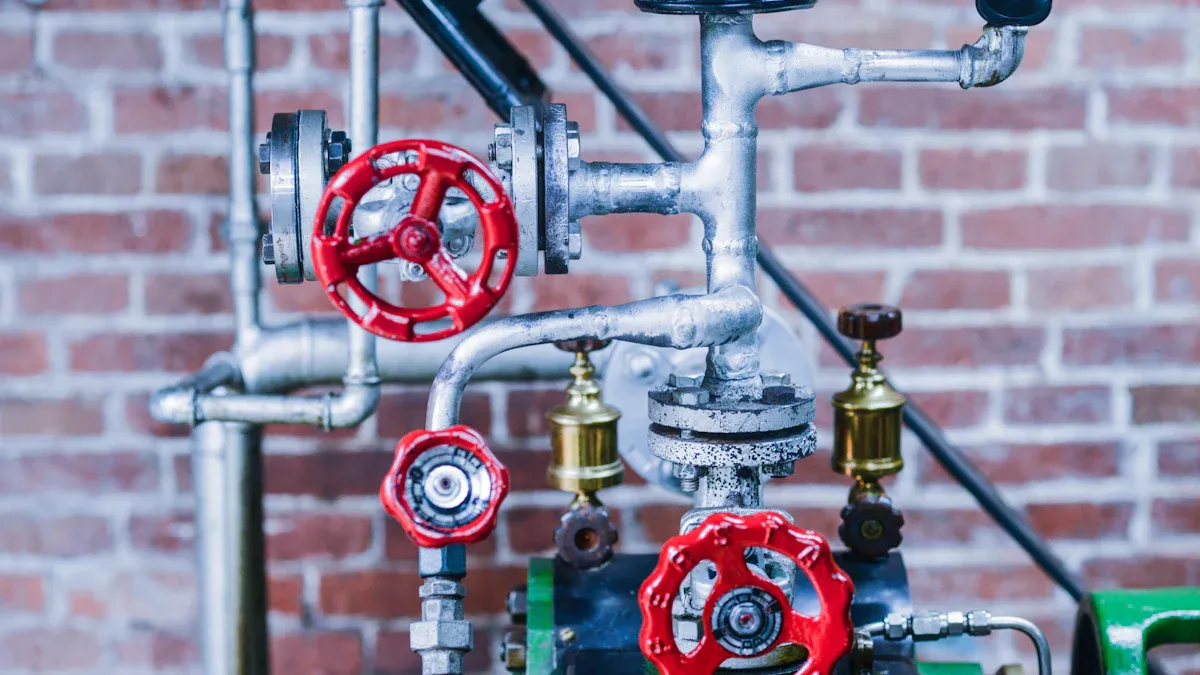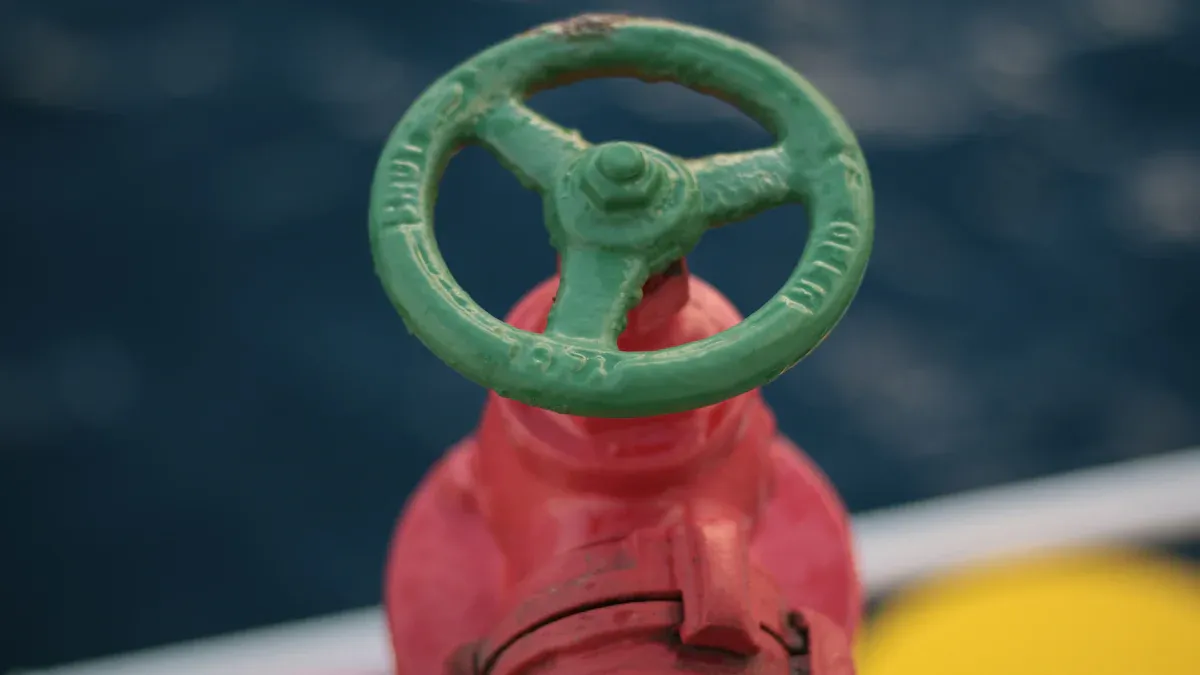
Material selection is crucial for ensuring the reliability of landing valves in fire protection systems. Brass and bronze, two widely used alloys, exhibit distinct physical properties and performance characteristics.
- Brass is highly resistant to corrosion, exceptionally malleable, and durable, making it an excellent choice for applications such as straight valves and pressure regulating valves.
- Bronze, while also corrosion-resistant, has higher porosity and reduced durability, which may lead to material degradation over time.
Choosing the appropriate material is essential to guarantee the longevity and optimal performance of landing valves, including PRV valves and pressure restricting valves, across diverse environmental conditions.
Key Takeaways
- Brass costs less and is simple to shape, so it works well for indoor fire systems with medium stress.
- Bronze is stronger and resists rust better, making it good for tough places like near the ocean.
- Picking the right material for landing valves depends on where it’s used and what it’s for to make sure it lasts and works well.
Material Composition of Landing Valves
Brass: Composition and Properties
Brass is an alloy primarily composed of copper and zinc, with the proportions varying based on the intended application. Copper content typically ranges from 55% to 95%, while zinc makes up 5% to 45%. Additional elements such as lead, iron, aluminum, nickel, and arsenic are often added to enhance specific properties.
- Lead improves machinability, making brass easier to shape during manufacturing.
- Iron increases strength, ensuring the material can withstand mechanical stress.
- Aluminum and nickel enhance corrosion resistance, making brass suitable for environments exposed to moisture or chemicals.
Brass is known for its excellent malleability, allowing manufacturers to create intricate designs for landing valves. Its corrosion resistance ensures durability in fire protection systems, where reliability is critical.
Bronze: Composition and Properties
Bronze is an alloy primarily consisting of copper and tin, with copper making up approximately 88% and tin around 12%. Additional elements such as aluminum, nickel, phosphorus, silicon, and manganese are often included to improve mechanical and chemical properties.
- Aluminum increases strength and corrosion resistance, making bronze ideal for marine environments.
- Nickel enhances tarnish resistance and overall durability.
- Phosphorus improves wear resistance, ensuring longevity in high-friction applications.
- Silicon and manganese contribute to mechanical strength and resilience.
Bronze exhibits high tensile strength and excellent corrosion resistance, particularly in harsh environments. For example, nickel aluminum bronze is widely used in aerospace components due to its tensile strength of 550 to 900 MPa and durability in marine conditions. Similarly, C932 bearing bronze, with a tensile strength of approximately 35,000 PSI, is commonly used in valve components.
Key Differences in Material Composition
The composition differences between brass and bronze significantly impact their physical properties and suitability for landing valves.
| Alloy | Main Components | Additional Elements and Their Effects |
|---|---|---|
| Bronze | Copper (88%), Tin (12%) | Aluminum (strength, corrosion resistance), Nickel (strength, tarnish resistance), Phosphorus (wear resistance), Silicon (strength), Manganese (mechanical properties) |
| Brass | Copper (55%-95%), Zinc (5%-45%) | Lead (machinability), Iron (strength), Aluminum (corrosion resistance), Nickel (corrosion resistance), Arsenic (corrosion resistance) |
Brass contains higher zinc content, which enhances its malleability and machinability, making it easier to manufacture landing valves with complex designs. Bronze, on the other hand, relies on tin and other elements to achieve superior strength and wear resistance, making it suitable for applications requiring durability under mechanical stress.
Quantitative differences further highlight their unique characteristics:
| Material | Copper (%) | Zinc (%) | Tin (%) | Other Elements |
|---|---|---|---|---|
| Brass | 57% to 63% | 35% to 40% | N/A | N/A |
| Bronze | Copper + Tin | N/A | N/A | Nickel, Manganese (possible additions) |
These differences underscore the importance of selecting the right material for landing valves based on specific application requirements and environmental conditions.
Corrosion Resistance in Landing Valves

Brass and Corrosion Resistance
Brass demonstrates excellent resistance to corrosion, particularly in environments with minimal exposure to harsh chemicals or extreme conditions. Its high copper content forms a protective oxide layer when exposed to air or water, which prevents further degradation. This property makes brass a reliable material for landing valves used in indoor fire protection systems or areas with controlled environmental conditions.
The addition of elements like aluminum and nickel further enhances brass’s ability to resist corrosion. Aluminum creates a thin, durable oxide layer that shields the material from moisture and chemical exposure. Nickel, on the other hand, improves tarnish resistance, ensuring the material retains its appearance and functionality over time. These characteristics make brass an ideal choice for applications requiring both durability and aesthetic appeal.
Bronze and Corrosion Resistance
Bronze offers superior corrosion resistance, especially in challenging environments such as marine or industrial settings. Its composition, primarily copper and tin, provides a natural barrier against oxidation and chemical reactions. The inclusion of elements like aluminum and phosphorus further strengthens its resistance to wear and corrosion.
Research highlights that nickel-aluminum bronze (NAB) exhibits enhanced corrosion resistance in marine environments. This improvement stems from the microstructural characteristics of NAB/steel composite structures, particularly those fabricated through Wire-Arc Additive Manufacturing (WAAM). The smaller grain size and limited precipitation of the κ phase in WAAM-NAB reduce selective phase corrosion, resulting in better overall performance. These properties make bronze a preferred material for landing valves exposed to saltwater or other corrosive substances.
Environmental Factors Impacting Corrosion
The environment plays a significant role in determining the corrosion resistance of materials used in landing valves. Factors such as humidity, temperature, and exposure to chemicals or saltwater can accelerate the corrosion process. For instance, brass performs well in dry or moderately humid conditions but may corrode faster in environments with high salinity or acidic exposure.
Bronze, with its robust composition, withstands harsher conditions, including marine environments and industrial applications. However, even bronze can experience degradation if exposed to extreme pH levels or prolonged contact with aggressive chemicals. Regular maintenance and proper material selection based on environmental conditions are crucial for ensuring the longevity and reliability of landing valves.
Durability and Strength of Landing Valves

Mechanical Properties of Brass
Brass exhibits a unique combination of strength and flexibility, making it a reliable material for landing valves. Its tensile strength typically ranges from 200 to 550 MPa, depending on the specific alloy composition. This strength allows brass to endure moderate mechanical stress without cracking or deforming. Additionally, its malleability ensures that manufacturers can shape it into intricate designs without compromising its structural integrity.
Brass also demonstrates excellent wear resistance, particularly in low-friction environments. This property reduces the likelihood of surface degradation over time, ensuring consistent performance. The inclusion of elements like iron and aluminum further enhances its mechanical stability, making it suitable for applications requiring both strength and precision.
Mechanical Properties of Bronze
Bronze is renowned for its superior strength and resilience under high-stress conditions. Its tensile strength typically ranges from 300 to 800 MPa, depending on the alloy. This makes bronze an excellent choice for applications where durability is critical. The addition of tin and other elements like phosphorus and manganese enhances its wear resistance, allowing it to withstand prolonged use in demanding environments.
Bronze also excels in high-friction applications due to its low coefficient of friction. This property minimizes wear and tear, extending the lifespan of components. Its ability to maintain structural integrity under extreme conditions makes it a preferred material for landing valves exposed to heavy mechanical loads.
Long-Term Durability in Landing Valve Applications
The long-term durability of landing valves depends on the material’s ability to resist wear, corrosion, and mechanical stress. Research on valve longevity, such as studies on transcatheter aortic valve implantation (TAVI), provides valuable insights. For example, the PARTNER-1 trial reported no structural valve deterioration (SVD) after five years, while another study observed a cumulative SVD incidence of 14.9% after seven years. These findings highlight the importance of selecting materials with proven durability for critical applications.
Brass and bronze both offer long-lasting performance when used in landing valves. However, the choice between the two depends on the specific application and environmental conditions. Brass is ideal for moderate stress and controlled environments, while bronze excels in high-stress or corrosive settings. Proper material selection ensures the reliability and longevity of landing valves in fire protection systems.
Cost and Machinability of Landing Valves
Cost Comparison: Brass vs. Bronze
Brass and bronze differ significantly in cost due to their composition and availability. Brass, composed primarily of copper and zinc, tends to be more affordable. Its widespread use in plumbing and industrial applications contributes to its lower price point. Bronze, which contains copper and tin, often incurs higher costs due to the scarcity of tin and the specialized alloys required for certain applications.
Manufacturers often choose brass for landing valves when cost efficiency is a priority. Bronze, while more expensive, offers superior strength and corrosion resistance, making it a preferred choice for high-stress environments. The decision between these materials depends on balancing budget constraints with performance requirements.
Machinability and Manufacturing Considerations
Machinability plays a critical role in determining the ease of manufacturing landing valves. Brass exhibits excellent machinability due to its malleability and lower hardness. This property allows manufacturers to produce intricate designs with minimal tool wear. Bronze, while durable, presents greater challenges during machining due to its higher hardness and tensile strength.
The table below highlights key machinability benchmarks for brass and bronze alloys:
| Alloy Type | Tensile Strength (ksi) | Yield Strength (ksi) | Elongation (%) | Hardness (Brinell) | Machinability (YB) |
|---|---|---|---|---|---|
| Red Brass | 83 | N/A | 32 | N/A | 35 |
| Manganese Bronze | 86 | 90 | 45 | 48 | 30 |
| Tin Bronze | 90 | 40 | 45 | 21 | 30 |
Brass’s higher machinability score makes it ideal for applications requiring precision and efficiency. Bronze, despite its lower machinability, remains a viable option for landing valves in demanding environments due to its mechanical strength.
Maintenance and Lifecycle Costs
Maintenance and lifecycle costs depend on the material’s durability and resistance to wear. Brass requires less frequent maintenance in controlled environments, reducing long-term expenses. However, in corrosive or high-stress conditions, bronze offers better longevity, offsetting its initial higher cost with reduced replacement frequency.
Selecting the right material for landing valves ensures optimal performance while minimizing overall costs. Manufacturers like Yuyao World Fire Fighting Equipment Factory prioritize material specifications to deliver reliable and cost-effective solutions for diverse applications.
Applications and Suitability of Landing Valves
Brass Landing Valves: Common Applications
Brass landing valves are widely used in environments where moderate mechanical stress and controlled conditions prevail. Their excellent corrosion resistance and malleability make them suitable for indoor fire protection systems, such as commercial buildings, residential complexes, and office spaces. These valves perform reliably in systems where exposure to harsh chemicals or extreme weather is minimal.
The ease of machining brass allows manufacturers to produce intricate designs, making it ideal for pressure-regulating valves and straight valves. Additionally, brass landing valves are often chosen for their aesthetic appeal, as they maintain a polished appearance over time. This combination of functionality and visual appeal makes brass a preferred choice for applications requiring both performance and design flexibility.
Bronze Landing Valves: Common Applications
Bronze landing valves excel in demanding environments where durability and corrosion resistance are critical. Their robust composition makes them ideal for outdoor fire protection systems, industrial facilities, and marine applications. These valves withstand high mechanical stress and resist wear, even in harsh conditions such as saltwater exposure or extreme temperatures.
Bronze’s superior strength and low friction properties make it suitable for high-pressure systems and heavy-duty applications. For example, bronze landing valves are commonly used in shipyards, offshore platforms, and chemical plants. Their ability to endure challenging environments ensures long-term reliability and safety in critical fire protection systems.
Choosing the Right Material for Specific Needs
Selecting the appropriate material for a landing valve depends on the application’s requirements and environmental conditions. Brass is an excellent choice for indoor or low-stress environments due to its affordability, machinability, and corrosion resistance. In contrast, bronze is better suited for high-stress or corrosive settings, where strength and durability are paramount.
Manufacturers like Yuyao World Fire Fighting Equipment Factory offer a range of landing valves tailored to diverse applications. Understanding the specific needs of a fire protection system ensures the selection of the most suitable material, enhancing the valve’s performance and longevity.
Brass and bronze differ in composition, corrosion resistance, durability, and cost. Brass offers affordability and machinability, while bronze excels in strength and resilience. Selecting the right material depends on environmental conditions and application requirements. Understanding material specifications ensures landing valves perform reliably and last longer in fire protection systems.
FAQ
What are the main factors to consider when choosing between brass and bronze landing valves?
Evaluate environmental conditions, mechanical stress, and budget. Brass suits controlled environments, while bronze excels in high-stress or corrosive settings.
How does corrosion resistance differ between brass and bronze?
Brass resists corrosion in moderate conditions. Bronze offers superior resistance, especially in marine or industrial environments, due to its robust composition.
Are brass landing valves more cost-effective than bronze?
Yes, brass is generally more affordable due to its composition and machinability. However, bronze’s durability may reduce long-term replacement costs in demanding applications.
Post time: May-04-2025

